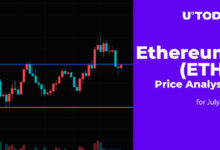Morgan Stanley’s New PAVA Indicator Divides ETH Users Into ‘Believers’ and ‘Speculators’

Morgan Stanley has introduced a new speculation indicator – a tool called PAVA (price-adjusted volume per address) that uses speculative activity among traders to forecast ether (ETH) pricing.
The indicator, calculated by dividing the cryptocurrency price in U.S. dollars by the ratio of the blockchain transaction volume to active wallet addresses (90-day average), will allow investors to estimate ether price trends, particularly when undergoing extreme market lows.
“The key assumption for the PAVA indicator is that the blockchain, or specifically the layer 1 blockchain, is valued as a network,” Morgan Stanley wrote.
The indicator differentiates price movement based on market fundamentals from price movement based on network usage, and divides crypto market participants into two groups: believers and speculators.
Believers are confident in Ethereum’s long-term value and participate in on-chain protocols such as staking and decentralized lending, which increases network transaction volume and results in a lower PAVA value.
Speculators are less well-integrated into the Ethereum ecosystem and react to short-term price movement, causing increases in active wallet addresses to outpace increases in transaction volume and resulting in a higher PAVA value.
Morgan Stanley said that the indicator is stronger at identifying lower, than higher, market extremes. PAVA has been cyclical in past years and tends to bottom out below 0.1 and peak above 0.29. The indicator recently dipped below the low threshold on June 16, two days before ETH hit a bottom of $880.18.






 Bitcoin
Bitcoin  Ethereum
Ethereum  Tether
Tether  USDC
USDC  TRON
TRON  Dogecoin
Dogecoin  Cardano
Cardano  Bitcoin Cash
Bitcoin Cash  Chainlink
Chainlink  LEO Token
LEO Token  Monero
Monero  Stellar
Stellar  Zcash
Zcash  Litecoin
Litecoin  Hedera
Hedera  Dai
Dai  Cronos
Cronos  OKB
OKB  Tether Gold
Tether Gold  Ethereum Classic
Ethereum Classic  KuCoin
KuCoin  Gate
Gate  Algorand
Algorand  Cosmos Hub
Cosmos Hub  VeChain
VeChain  Dash
Dash  Tezos
Tezos  Stacks
Stacks  TrueUSD
TrueUSD  IOTA
IOTA  Basic Attention
Basic Attention  Theta Network
Theta Network  Decred
Decred  NEO
NEO  Qtum
Qtum  Synthetix
Synthetix  Ravencoin
Ravencoin  0x Protocol
0x Protocol  DigiByte
DigiByte  Zilliqa
Zilliqa  Nano
Nano  Numeraire
Numeraire  Holo
Holo  Siacoin
Siacoin  Waves
Waves  Ontology
Ontology  Enjin Coin
Enjin Coin  Status
Status  BUSD
BUSD  Pax Dollar
Pax Dollar  Hive
Hive  Lisk
Lisk  Steem
Steem  Huobi
Huobi  NEM
NEM  OMG Network
OMG Network  Augur
Augur  Bitcoin Gold
Bitcoin Gold  Ren
Ren